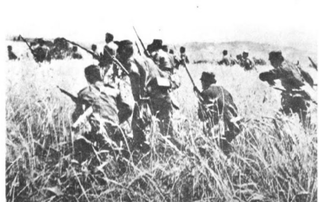Thracian Theater
First Army

First Army was commanded by lieutenant-general Vasil Kutinchev.
- 1st Sofia Infantry Division ( Major-General Toshev)
- 1st Brigade (Colonel Zheliavski)
- 1st "Sofia" Infantry Regiment
- 6th "Turnovo" Infantry Regiment
- 2nd Brigade (Major-General Popov)
- 37th Infantry Regiment
- 38th Infantry Regiment
- 4th QF FAR [Note 1]
- 4th FAR
- 1st Pioneer Battalion
- 1st Brigade (Colonel Zheliavski)
- 3rd Balkan Infantry Division ( Major-General Sarafov)
- 1st Brigade (Colonel Paskalev)
- 11th "Sliven" Infantry Regiment
- 24th "Black Sea" Infantry Regiment
- 2nd Brigade (Colonel Ribarov)
- 29th "Yambol" Infantry Regiment
- 32nd "Zagora" Infantry Regiment
- 3rd Brigade (Major-General Tepavicharov)
- 41st Infantry Regiment
- 42nd Infantry Regiment
- 6th QF FAR
- 6th FAR
- 3rd Pioneer Battalion
- 1st Brigade (Colonel Paskalev)
- 10th Infantry Division ( Major-General Bradistilov)
- 1st Brigade (Colonel Petev)
- 16th "Lovech" Infantry Regiment
- 25th "Dragoman" Infantry Regiment
- 2nd Brigade (Colonel Atanas Petrov)
- 47th Infantry Regiment
- 48th Infantry Regiment
- 10th FAR
- 10th Pioneer Battalion
- 1st Brigade (Colonel Petev)
Second Army
Second Army was commanded by lieutenant-general Nikola Ivanov.
- 8th Tundzha Infantry Division ( Major-General Kirkov)
- 1st Brigade (Colonel Marchin)
- 10th "Rhodope" Infantry Regiment
- 30th "Sheinovo" Infantry Regiment
- 2nd Brigade (Colonel Kardzhiev)
- 12th "Balkan" Infantry Regiment
- 23rd "Shipka" Infantry Regiment
- 3rd Brigade (Colonel Pachev)
- 51st Infantry Regiment
- 52nd Infantry Regiment
- 8th QF FAR
- 8th FAR
- 8th Pioneer Battalion
- 1st Brigade (Colonel Marchin)
- 9th Pleven Infantry Division ( Major-General Sirakov)
- 1st Brigade (Colonel Evrov)
- 4th "Pleven" Infantry Regiment
- 17th "Dorostol" Infantry Regiment
- 2nd Brigade (Colonel Popov)
- 33rd "Svishtov" Infantry Regiment
- 34th "Troyan" Infantry Regiment
- 3rd Brigade (Colonel Grancharov)
- 53rd Infantry Regiment
- 54th Infantry Regiment
- 9th QF FAR
- 9th FAR
- 9th Pioneer Battalion
- 1st Brigade (Colonel Evrov)
- Haskovo Detachment ( Colonel Delov)
- 2/2nd Brigade
- 28th "Stremski" Infantry Regiment
- 40th Infantry Regiment
- 3rd FAR
- 2/2nd Brigade
- Mixed Cavalry Brigade (Colonel Tanev)
- 3rd Cavalry Regiment
- 6th Cavalry Regiment
Third Army

Third Army was commanded by lieutenant-general Radko Dimitriev.
- 4th Preslav Infantry Division ( Major-General Boyadzhiev)
- 1st Brigade (Colonel Todorov)
- 7th "Preslav" Infantry Regiment
- 19th "Shumen" Infantry Regiment
- 2nd Brigade (Colonel Enchev)
- 8th "Primorski" Infantry Regiment
- 31st "Varna" Infantry Regiment
- 3rd Brigade (Major-General Tserkovkski)
- 43rd Infantry Regiment
- 44th Infantry Regiment
- 5th QF FAR
- 5th FAR
- 4th Pioneer Battalion
- 1st Brigade (Colonel Todorov)
- 5th Danube Infantry Division ( Major-General Hristov)
- 6th Bdin Infantry Division ( Major-General Tenev)
- 1st Brigade (Colonel Kantardzhiev)
- 3rd "Bdin" Infantry Regiment
- 15th "Lom" Infantry Regiment
- 2nd Brigade (Colonel Pakov)
- 35th "Vratsa" Infantry Regiment
- 36th "Kozloduy" Infantry Regiment
- 2nd FAR
- 6th Pioneer Battalion
- 1st Brigade (Colonel Kantardzhiev)
Cavalry
The single Bulgarian cavalry division served independently on the Thracian Theater:
- Cavalry Division ( Major-General Nazlamov)
- 1st Brigade (Colonel Salabashev)
- 1st Cavalry Regiment
- 2nd Cavalry Regiment
- 2nd Brigade (Colonel Danailov)
- 4th Cavalry Regiment
- 7th Cavalry Regiment
- 10th Cavalry Regiment
- 1st Brigade (Colonel Salabashev)










